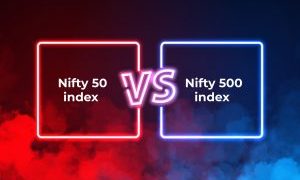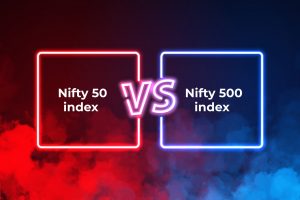Index funds, those that mirror the performance of specific stock market indices, have become a critical tool for investors seeking to tap into the prowess of the market without the need to pick individual stocks. Let’s get to know 2 of the most interesting indices in the Indian stock market.
Enter the Nifty 50 and the Nifty 500.
A fascinating fact? The Nifty 500 Index represents about 92.1%* of the free float market capitalization of the stocks listed on the NSE as of March 29, 2019. Such statistics underline the immense scope and influence of these indices.
Key Takeaways for Beginners:
Key Takeaways for Beginners:
- Both Nifty 50 and Nifty 500 index offer unique advantages. While the Nifty 50 provides stability and consistent dividends, Nifty 500 offers broader market exposure and potential growth opportunities.
- Liquidity matters! Nifty 50 stocks are generally more liquid but don’t discount the potential of the vast array of stocks within the Nifty 500.
What is the Nifty 50 Index?
The Nifty 50 Index is a well-recognised benchmark for the Indian stock market, comprising 50 of the largest and most actively traded stocks on the National Stock Exchange (NSE). These companies represent key sectors of the economy and are selected based on their liquidity and market capitalisation.
As the barometer of the Indian equity market, the Nifty 50 plays a significant role in indicating the overall health and direction of the economy. It’s closely watched by investors, analysts, and policymakers alike.

Pros and Cons for Investors:
Pros:
- Represents the elite of the Indian corporate sector.
- Highly liquid, making it easier for investors to buy or sell.
- Used as a reference for various investment products like mutual funds and ETFs.
Cons:
- Limited to just 50 companies, potentially missing out on other promising stocks.
- Might not offer comprehensive coverage of the broader market.
What is the Nifty 500 Index?
Venturing beyond the top 50 stocks, the Nifty 500 Index offers a comprehensive snapshot of the Indian stock market. As the name suggests, it comprises 500 companies, including every entity from the Nifty 50. This index fund based on Nifty 500 presents a broader view of the market’s performance.
The Nifty 500 index fund is like a vast library of the Indian corporate world. By encompassing 500 firms, it covers diverse sectors, right from the old giants to the emerging players, giving investors a thorough insight into the market’s depth and range.
Pros and Cons for Investors:
Pros:
- Broader exposure to various sectors and industries.
- Reduced impact of any single company’s performance on the overall index.
- Suitable for those seeking diversified investment.
Cons:
- This might include companies with lower liquidity.
- Requires more research and understanding due to its extensive nature.
Depending on investment goals, one might choose between the two, but understanding their intricacies is paramount.
Comparing Nifty 50 and Nifty 500 Index Fund
The Indian stock market, one of the most vibrant in the world, offers a plethora of investment options. Among these, index funds have been garnering significant attention. Two major players in this domain are Nifty 50 and Nifty 500 index fund.
While both aim to replicate the performance of their respective indices, they cater to different investment needs and preferences.
Let’s dive deeper into a comparative analysis of these two:
| Parameter | Nifty 50 | Nifty 500 |
| Composition | Top 50 companies by market capitalisation | Top 500 companies by market capitalisation |
| Diversification | Limited to top 50 companies | Extensive, includes mid and small-cap companies |
| Volatility | Relatively more stable due to large-cap focus | Slightly higher due to broader market exposure |
| Liquidity | Highly liquid | Moderate liquidity, varying across stocks |
| Benchmarked Products | Numerous products, including ETFs and mutual funds | Fewer products compared to Nifty 50 |
| Market Representation | Represents major sectors and large-cap dominance | Comprehensive representation of the market |
| Investment Horizon | Suitable for medium to long-term | Recommended for a longer term due to diverse exposure |
| Popularity | More popular and widely recognised | Gaining traction among keen market observers |
Understanding Index Fund Investment Based on Nifty 500
The index fund based on Nifty 500 is a popular choice for those looking for broader market exposure, encapsulating the vastness and diversity of the Indian stock market.
This comprehensive coverage offers an opportunity to tap into the potential of not just the market leaders but also the rising stars.
Broader Market Exposure:
Unlike its Nifty 50 counterpart, investing in an index fund based on Nifty 500 allows investors to gain exposure across a wide array of sectors. This includes not only the large-cap companies but also the mid and small-cap sectors which often hold significant growth potential.
Reduced Risk:
Diversification is a key tenet of investment, and the Nifty 500 index fund embodies this principle. With assets spread across 500 companies, the risk associated with the underperformance of a particular sector or company is significantly diluted.
Cost-Effective:
Generally, Nifty 500 index funds have a lower expense ratio than actively managed funds. This is because they simply aim to replicate the index’s performance, negating the need for extensive research and active management.
Performance Tracking:
While no investment comes with a guarantee, the Nifty 500 index fund offers a reliable gauge of the broader market’s performance. By tracking the index, it provides a transparent view of its holdings and the rationale behind its performance, making it easier for investors to make informed decisions.
The choice between Nifty 50 and Nifty 500 largely depends on individual investment goals. While the former offers stability and recognition, the latter provides extensive market coverage and diversification.
Dividend Yields and Returns: A Snapshot of Nifty 50 vs. Nifty 500
In the world of index investments, the ultimate yardstick of performance lies in yields and returns. Understanding how the Nifty 500 index fund fares against the Nifty 50 in terms of dividends and returns is crucial for every savvy investor.
Let’s dive into a comprehensive analysis of these aspects.
Historically, the Nifty 50, consisting of the top 50 blue-chip companies, has been perceived to offer more stable dividend yields, largely because these companies have consistent profit generation.
On the other hand, the Nifty 500 index fund encompasses a broader spectrum, making its dividend patterns slightly more volatile. Yet, its inclusion of mid and small-cap stocks offers the potential for higher returns, especially during bullish market periods.
In terms of annual returns, the Nifty 500 often showcased a marginally higher percentage, owing to its broader market coverage. For income-focused investors, the consistent dividends of Nifty 50 might seem more appealing, but those looking for growth might lean towards the Nifty 500.
Trading Volumes in Nifty 50 vs. Nifty 500 Stocks
Trading volumes often serve as a testament to the popularity and liquidity of stocks. The Nifty 50, with its repertoire of major players, tends to enjoy high trading volumes, indicating substantial liquidity.
This essentially means that investors can quickly buy or sell Nifty 50 stocks without causing significant price changes.
Conversely, while many stocks within the Nifty 500, especially the large-cap ones, experience similar trading volumes, the smaller-cap stocks might not share the same liquidity. This is vital for investors to consider as it impacts how easily they can offload or accumulate stocks, especially in large quantities.
Final Thoughts
The choice between the Nifty 50 and the Nifty 500 index fund hinges on individual investment strategies and objectives. While the former offers stability with its top-tier stocks, the latter promises comprehensive exposure to the diverse Indian market.
As you start your investment journey, take a moment to reflect on your financial aspirations and risk tolerance. Remember, the stock market is not just about following the crowd but about making informed decisions that align with your goals.
Ready to dive in? Start your investment journey today and let the indices guide your way.
Disclaimer: This publication is pursuant to Investor Education and Awareness Initiative by Motilal Oswal Mutual Fund. This shall not be construed as offer to invest in any financial product or Scheme. The objective of this publication is restricted to informational purposes only. All investors have to go through a one-time KYC (Know Your Customer) process. For further details on KYC, Change of address, phone number, bank details etc. list of SEBI registered Mutual Funds and redressal of complaints including details about SEBI SCORES portal, visit link https://www.motilaloswalmf.com//New_Page/KYC-and-Redressal-of-Complaints/9. SMART ODR portal, visit link https://smartodr.in/login. Investors should invest only with SEBI registered Mutual Funds details of which can be verified on the SEBI website under “SEBI Intermediaries/ Market Infrastructure Institutions.
This blog has been issued on the basis of internal data, publicly available information and other sources believed to be reliable. The information contained in this document is for general purposes only and not a complete disclosure of every material fact. The information/data herein alone is not sufficient and shouldn’t be used for the development or implementation of an investment strategy. It should not be construed as investment advice to any party the blog does not warrant the completeness or accuracy of the information and disclaims all liabilities, losses and damages arising out of the use of this information. Mutual Funds are subject to market risk. Read the offer documents before investing. Readers shall be fully responsible/liable for any investment decision taken on the basis of this article.
The sector mentioned herein are for general assesment purpose only and not a complete disclosure of every material fact. It should not be construed as investment advice to any party. Past performance may or may not be sustained in future.
Mutual Fund investments are subject to market risks, read all scheme related documents carefully.












































